WHICH SONY E-MOUNT LENS TO BUY?
In this post we will look at the best E-mount lenses compatible with Sony’s range of APS-C mirrorless cameras, whether Nex (5,6,7) or Alpha (a3000, a5000, a6000, a6300, a6400 or 6500…).
Thanks to this buying guide you will know exactly which E-mount lens to get according to your budget and what type of photos you want to shoot whether for portrait, landscape or travel photography.
Note: Product links in this article lead to Amazon
Summary
- Sony 18-105mm f/4
- Sigma 16mm f/1.4
- Sigma 30mm f/1.4
- Sony 10-18mm f/4
- Sony 50mm f/1.8 OSS
- Sony Zeiss 16-70mm f/4
- Sony FE 85mm f/1.8
- Sony 30mm f/3.5 macro
- Sony 55-210mm
- Sony FE 70-300mm f/3.5-5.6
- More Sony E-mount lenses to consider
- Comparative table
- How to choose the best Sony E-mount lens?
Sony 18-105 mm f/4 OSS
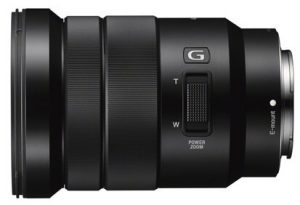
Full-frame equivalent: 27-157,5 mm
Filter size: 72 mm
A somewhat heavy lens but which has a constant f/4 aperture and a versatile focal range, which can be useful if you are looking for a good lens to take on a trip.
It is solid, the focus is fast and precise and it has an optical stabilizer to be able to obtain sharp pictures in all circumstances. Apparently there is a lot of deformation if you shoot in RAW at 18mm (not so much in jpeg). It’s also one of the best sony e-mount lenses for video.
Another similar (or even better) option would be the 16-70mm but it costs almost twice as much…
_
Sigma 16mm f/1.4 DC DN Contemporary
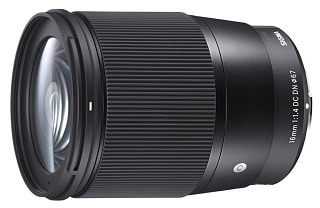
Full-frame equivalent: 24 mm
Filter size: 67 mm
This is a fantastic wide angle lens, great for low light situations, and a versatile focal range useful for landscapes, astrophotography and street photography. It’s very well build and feels solid, and gives extremely sharp images even in low light, from center to corners, with nice colors and contrat. The only weakness is that there’s a bit of barel distortion however if you shoot your subjects too close.
The large aperture of f/1.4 is excellent for low light and for creating a nice depth of field. It’s not that compact and could be a little smaller, but fast lenses need lots of glass to get that light.
Autofocus is smooth and fast (one of the fastest from Sigma actually), and it performs very well in video, but since it’s non-stabilized you’ll have to combine it with a stabilized camera like the a6500 to get optimal results. That being said, it should not discourage you to get it if you mainly shoot photos and your camera doesn’t have in-body image stabilisation.
Overall, it’s one of the best lenses for Sony E-mount APS-C cameras, and easy to recommend thanks to it’s impressive performances.
_
Sigma 30mm f/1.4 DC DN Contemporary
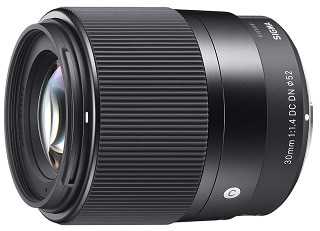
Full-frame equivalent: 45 mm
Filter size: 52 mm
This is a superb compact lens equivalent to a 45 mm on a Full-frame camera, with a great versatility: it’s well suited for portraits, reporting, product photography or street photography.
It suffers from moderate barrel distortion and minor vignetting when at f/1.4 but overall its optical quality is just excellent: color rendition is amazing, it’s exceptionally sharp, and its very large aperture of f/1.4 gives a superb bokeh and makes it very good for low-light conditions.
Handling is excellent, its quality of construction is very good, autofocus is good and it’s a lightweight.
The negative points: it’s not weather sealed and it has no optical stabilisation (that might be a problem if you mainly shoot video and your camera doesn’t have in-camera stabilisation). That being said, it gives amazing results and it’s an affordable lens, which makes it one of the best for Sony E-mount APS-C cameras.
_
☛ OTHER OPTION
- Sony 35mm f/1.8 OSS (Weight: 155g/5.5 oz | FF equivalent: 52.5 mm | Filter size: 49mm) – It’s noticeably smaller and lighter than the Sigma, autofocus is much more accurate, and it has optical stabilization (OSS); the Sigma is slightly wider than the Sony 35mm, it’s also brighter and colors on the Sigma are more vivid. It’s a really good lens, but the Sigma is a bit better and unless you absolutely need the OSS and a perfect autofocus, I would recommend the Sigma (the Sony 35mm is also more expensive).
_
Sony 10-18 f/4 OSS
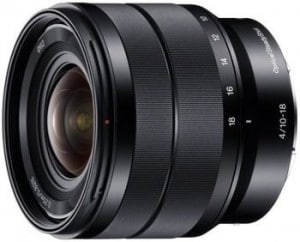
Full-frame equivalent: 15-27 mm
Filter size: 62 mm
The best wide angle lens for Sony E-mount cameras: it’s great for travelling and if you want to shoot architecture photos, landscapes, car interiors, Real Estate photography, basically for anywhere you’ll need a wide field of view.
It has OSS (optical Steadyshot) so it’s good for handheld videos, especially if you do vlogging. It’s also really compact, and surprisingly light.
That being said, if you’re looking for a good wide angle lens for your Sony APS-C mirrorless camera, then the Sony 10-18 f/4 is a must have.
_
Sony E 50mm f/1.8 OSS
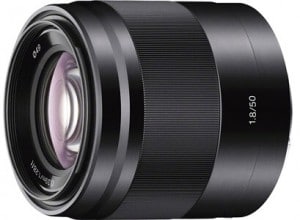
Full-frame equivalent: 75 mm
Filter size: 49 mm
One of the best compatible E-mount lenses, great for portraits and street photography: It offers very sharp images with little distortion or vignetting, and you get a superb bokeh even in low light.
Autofocus is silent and accurate, and it has an integrated optical stabilizer so it’s especially suitable if you make video.
With this type of lens you clearly realize the difference with the basic kit lens, and if you’re a beginner who’s looking for the best E-mount lens you’ll be able to shoot impressive pictures very quickly.
_
☛ OTHER OPTION
- Sigma 56mm f/1.4 (Weight: 280g/9.88 oz | Full-frame equivalent: 84mm | Filter size: 55mm) – A very good alternative to the Sony, if not better depending what you’re looking for and your budget: the Sigma 56mm f/1.4 is much sharper, gives better images in low light, and is slightly more compact with a larger front element. However, it doesn’t have OSS, it’s autofocus is a tiny bit slower (but still perfectly fine) and it’s more expensive. Whether you choose one or the other, they are both excellent and highly recommended.
_
Sony Zeiss 16-70mm f/4 ZA OSS
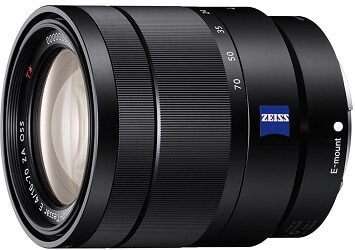
Full-frame equivalent: 24-105 mm
Filter size: 55mm
An excellent lens if you only need an all-in-one lens, very versatile (wide angle, portraits, lansdcapes), compact and not heavy so pretty useful for travel. It delivers pretty sharp images with a good color rendition, and it’s particularly good for video thanks to its silent autofocus.
This lens is controversial since there are some mixed user reviews about it: Sony sold some bad copies with soft corners, it’s not weather sealed, a bit pricey and a little bit old…
However its overall optical performances are really good, it’s well built and simply easy and pleasant to use if you don’t want to always be switching multiple lenses.
_
Sony E 30mm f/3.5 Macro
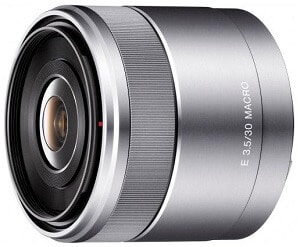
Full-frame equivalent: 45 mm
Filter size: 49 mm
This is the perfect lens (and maybe the best option) if you want to take pictures of insects, flowers or small details with your Sony E-mount camera. It offers surprising results, as long as you don’t move a muscle (there is no integrated optical stabilization). You can see incredible details on a picture of a spider for example!
Drawbacks: in addition to the lack of integrated stabilization, the autofocus hunts a little bit when the light is low. Apart from that, it’s a fun lens to use.
_
Sony FE 85mm f/1.8
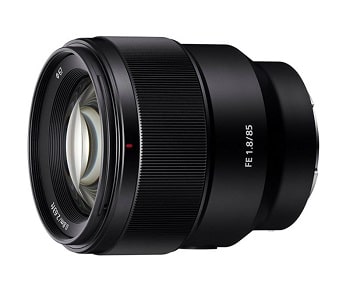
Filter size: 67 mm
Technically this lens is optimized for full-format cameras but it works perfectly on Sony APS-C sensor cameras: the field of view then becomes equivalent to a 127.5mm. It’s actually one of the best Sony E-mount lenses for portraits or events photography. It’s sold at a reasonable price and delivers sharps images with a very beautiful bokeh.
The autofocus is incredibly fast and quiet, and its weight is light enough thanks to a mainly plastic construction. In short, if you are looking for a perfect lens for everyday portrait or even landscape photography, it’s a must-have.
_
Sony 55-210mm f/4.5-6.3 OSS
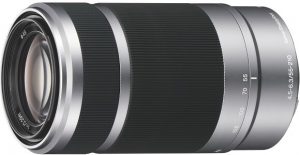
Full-frame equivalent: 82,5-315 mm
Filter size: 49mm
If you haven’t already had it with your camera (it often sold as a kit lens), it can be an interesting lens to own when you want to shoot from a distance.
Let’s be honest, image quality is good but not outstanding, but there are not so many telephoto zoom lens options for Sony E-mount mirrorless cameras, and it’s a fun lens to use if you want to shoot animals or people from a distance.
It has integrated optical stabilization which is a good point for a zoom of this type, and it’s sold at an affordable price.
_
Sony FE 70-300mm f/4 G OSS
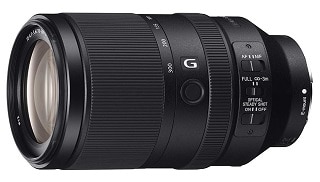
Full-frame equivalent: 105-450mm
Filter size: 72 mm
If you need more reach for wildlife photography or sports events, a better option than the 55-210mm is the Sony 70-300mm f/4.5-5.6 G OSS: Although this lens is optimized for full-format cameras, it works perfectly on Sony APS-C sensor cameras and you’ll get a 105-450mm equivalent, so that’s twice the focal lenght of the 55-210mm.
There’s no real alternative, but overall it offers excellent performances: it focuses quickly and offers pleasing results in terms of image quality when used in good conditions (it’s much, much sharper than the 55-210mm). Its OSS is amazing and is incredibly useful for hand held shots (but images are sharper when OSS is turned off).
The main drawback is its weight (it’s heavy and bulky) and its variable aperture: it will struggle in low-light situation and you’ll have to increase your ISO or only use it in good lighting situations.
_
More Sony E-mount lenses to consider
Sony 20mm f/2.8 (Weight: 69g | FF equivalent: 30 mm | Filter size: 49mm):
It’s a tiny wide angle pancake lens (ultra-flat) that fits in the pocket. This is the smallest lens in this selection, compatible with a wide angle adapter and the fisheye adapter. A good option if you need the lightest combo possible.
Sony 16mm f/2.8 (Weight: 67g | FF equivalent: 24 mm | Filter size: 49 mm):
Another tiny, lightweight pancake lens with an even wider focal range, and combined with a ultra wide adapter it’s a fun lens if you want to get into very wide angle photography at a low budget and a good alternative if you don’t have the money for the 10-18mm. The image quality is far from being incredible but I think it’s very correct, despite the many criticisms.
Sigma 60 mm f/2.8 DN ART (Weight: 185 g | FF equivalent: 90 mm | Filter size: 46 mm):
Maybe the best value for money from this list. Its sharpness is impressive, there’s no integrated stabilization but you can’t be disappointed by this lens considering the price and the optical quailty it offers.
Sigma 30mm f/2.8 DN ART (Weight: 132g | FF equivalent: 45 mm | Filter size: 46 mm):
Like the 60mm, it’s an excellent budget-friendly lens, versatile, strong but lightweight to carry, and it offers superb images. Unfortunately like the 60mm it’s not stabilized. Just like the 60mm it makes a weird noise when shaken slightly, but this is normal (that’s the autofocus motor).
_
COMPARATIVE TABLE
Sorted by price, from cheapest to most expensive. Do not hesitate to leave a comment if you notice any mistakes.
Note: OSS means that the lens is stabilized.
| Lenses | Price | Weight | Aperture | Utility | Stabilization |
|---|---|---|---|---|---|
| Sigma 30mm f/2,8 DN ART | $$$$$ | 132 g | f/2.8 | street photography | no |
| Sigma 60mm f/2.8 | $$$$$ | 185 g | f/2.8 | portrait | no |
| Sony E 30mm f/3.5 Macro | $$$$$ | 138 g | f/ 3.5 | macro | no |
| Sony 16mm f/2.8 | $$$$$ | 67 g | f/2.8 | pancake/wide angle | no |
| Sony 20mm f/2 | $$$$$ | 69 g | f/2.8 | pancake/wide angle | no |
| Sony E 50mm f/1.8 OSS | $$$$$ | 202 g | f/ 1.8 | portrait | yes |
| Sony 55-210mm f/4.5-6.3 OSS | $$$$$ | 345 g | f/4.5-6.3 | zoom | yes |
| Sony 35mm f/1.8 OSS | $$$$$ | 154 g | f/1.8 | street photography | yes |
| Sony 18-105mm f/4 E PZ G OSS | $$$$$ | 427 g | f/4 | all-in-one | yes |
| Sigma 16mm f/1.4 | $$$$$ | 405g | f/1.4 | wide angle | no |
| Sigma 30mm f/1.4 | $$$$$ | 265gg | f/1.4 | street photography | no |
| Sigma 56mm f/1.4 | $$$$$ | 280g | f/1.4 | portrait | no |
| Sony FE 85mm f/1.8 | $$$$$ | 371g | f/1.8 | portrait | no |
| Sony 10-18mm f/4 OSS | $$$$$ | 225 g | f/4 | ultra wide angle | yes |
| Sony FE 70-300mm f/4 G OSS | $$$$$ | 225 g | f/4 | telezoom | yes |
| Sony Vario-Tessar T* E 16-70mm f/4 ZA OSS | $$$$$ | 308 g | f/4 | all-in-one | yes |
_
HOW TO CHOOSE THE BEST SONY E-MOUNT LENS?
Basically the important points to consider before choosing your next E-mount lens are:
- Your favorite type of photography: zoom or fixed focal length? Do you need an all-in-one and versatile lens for travel, or for macro (insects, flowers…)? Maybe a wide angle to take landscapes or architecture in pictures?
- Price: what is your budget? Lenses are classified by price in the comparative table at the end of the article.
- Weight and height: the more bulky a lens is, the less you will want to take it with you and therefore take pictures.
- Aperture: indicated by f/1.8, f/2 etc….
- Focusing speed: not all lenses are effective on this point! On all the lenses presented here the focus is automatic.
Tips:
- Update your device’s software. New versions of your camera’s firmware may allow better compatibility with the lenses (especially faster autofocus).
- Shoot your photos in Raw and edit them on your computer: you will get better results than in jpeg. If you are not a professional, you don’t need to spend a lot of money on Lightroom-style editing software. You can use Rawtherapee: it’s free and allows you to learn how to retouch photos.
- Lenses marked FE (full-frame E-mount) are optimized for full-frame cameras like the Alpha 7, 7III… the other lenses mentioned here can also be used but in crop format, so not to the maximum of the possibilities of the Sony full format cameras.
- The integrated optical stabilization allows you to take a sharp picture even if your hand shakes a little. Lenses with this capability are labelled OSS (Optical Steady Shot).
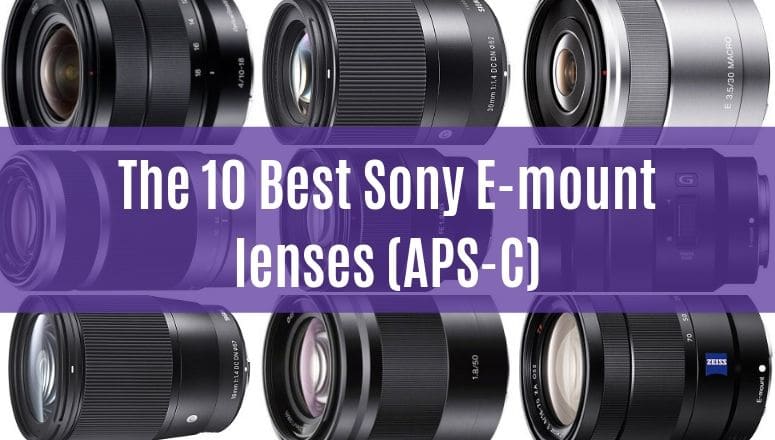
1 thought on “The 10 best Sony E-mount lenses to buy”